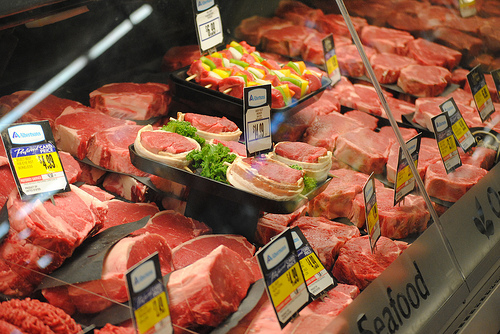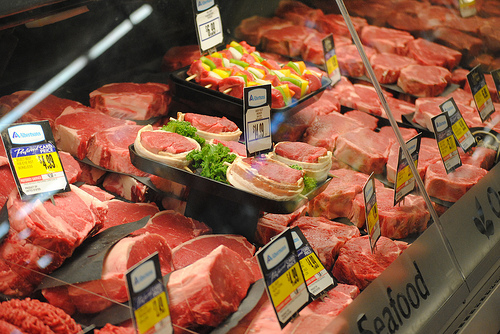 Let’s fill meat counters with ethical, sustainable cuts.Photo: Anthony AlbrightRecently, I have made the argument in a couple of different articles (here and here) that in order to make local-regional meat broadly affordable and accessible, we should make a shift from the direct markets (farmers markets, CSAs, on-farm sales) to the existing indirect, arms length markets of supermarkets (and mom and pop groceries and butcher shops).
Let’s fill meat counters with ethical, sustainable cuts.Photo: Anthony AlbrightRecently, I have made the argument in a couple of different articles (here and here) that in order to make local-regional meat broadly affordable and accessible, we should make a shift from the direct markets (farmers markets, CSAs, on-farm sales) to the existing indirect, arms length markets of supermarkets (and mom and pop groceries and butcher shops).
Coming from me, if you know my politics and you know the history of my writings, this is a shocking claim. Nevertheless, I have been thinking about it very hard over the last few days, in light of the comments I have received, and I do still think it is the right thing to do. Given our meat-intensive culture, it is unfair to ask people of limited means to eat only cheap cuts and/or to substantially reduce their meat consumption. As I argued yesterday, bucking one’s cultural impulses often takes Herculean efforts. Being poor is challenging enough already; we shouldn’t also force counter culturalism on poor people. As much as I dislike our culture of rampant, unbridled meat consumption, I think, until we are able to change that culture — and I truly hope we are able to — that poor people have as much right to it as the well-off. I believe it so strongly that I see making local-regional meat broadly affordable and readily available as an ethical imperative.
Why, or how, is it that when supermarkets are so much a part of our food, socioeconomic, and health problems that it could possibly be supermarkets that can answer this call? It’s something like sleeping with the enemy, isn’t it?
Yes, and no.
First, I need to admit right up front that this effort could fail miserably, for a few reasons:
- As far as being able to gather enough local-regional meat together to be able to satisfy the daily needs of supermarkets, I might very much be putting the cart before the horse. Without the necessary infrastructural developments already in place, making this effort might be impossible.
- We can only move into supermarkets if it means not compromising our farming ethics, especially as it relates to animal welfare, environmental/ecological concerns, and our belief that farmers should be fairly compensated for their work. It might be possible that supermarkets are unwilling or unable to pay farmers what they need to be paid without compromising those values.
- Even if we can get local-regional meat into supermarkets, it might only be possible by pricing meat at levels that are still out of the reach of people of limited means.
Nevertheless, right now, at this moment, I believe that supermarkets are the only way to make local-regional meat as broadly affordable and readily available as I would like to make it. As I have said, I want local-regional sales to account for 30 percent of total sales, not 2 percent.
In terms of expanding access by making local-regional meat more broadly available and affordable, volume is the key. Currently, local-regional agriculture is carried out very much on a small scale. Each individual farm produces a low-volume of meat. Many, perhaps most, of these farms raise a dozen or two, maybe 30, or as many as 40 pigs per year.
Dickson’s Farmstand Meats, the butcher shop I work with in New York City, alone needs 30 pigs per month. That means that in order to satisfy his needs, Jake Dickson would need to work with 12 different low-volume farmers in order to meet his needs. That would be a logistical and bookkeeping nightmare, not to mention that working with so many farmers substantially increases the likelihood that a farmer here and there is going to flake out and either not make a delivery or come up short or not send the sort of animal (finish-wise) that she/he promised. So, instead, Jake sought out and found just a few local-regional farmers to work with that are farming on a larger scale than the typical low-volume local-regional farm, including me. Working with fewer farmers substantially reduces the time it takes to manage logistics and bookkeeping, and it also makes it so the quality of the meat on offer at the shop is more consistent, and more reliably delivered, than it would be if it were coming from 12 different farms.
Jake’s is a small butcher shop, located in a high-end market, frequented by people that are definitely not of limited means, so in spite of the fact that he is buying wholesale — I will sell him more than 250 pigs this year — he is able to compensate his farmers fairly. Those of us who are working with Jake are able to make a living.
What about a supermarket? Assuming that it would be possible for us to meet the volume needs of supermarkets, which would be substantially higher than at Dickson’s, would they be able (and willing) to compensate farmers fairly, especially if they were offering local-regional meat at more affordable prices?
I believe they would be able to, but not without us making some changes on our end. We would need to add to our plethora of small-scale local-regional farms a large number of mid-sized farms, composing an “agriculture of the middle,” that raise not a couple or a few dozen pigs per year, but 500-1,000+. If you think that in order to raise that many pigs, animal welfare or environmental/ecological concerns need to be compromised, check out Jude Becker’s operation (6,000 pigs per year), or Greg Gunthorp’s (1,000 pigs per year), or Paul Willis’s (2,500 pigs per year). Also, Animal Welfare Approved, which has the highest animal welfare standards around, has plenty of pig farmers farming at this scale.
Scale does two things. First, it makes it so the supermarkets can work with us. They wouldn’t be willing to work with 100 different farmers to meet their needs. Second, it means that the farmers that they do work with can be paid less for their pigs and still make a living. If the farmers are paid less, and we have done the hard work to convince supermarkets of the value of making local-regional meat more broadly affordable, then that lower compensation can translate into lower prices for local-regional meat on the supermarket shelves.
Will it ever be as cheap as industrial meat? No, and I have never argued that it would, or should, be. Will local-regional meat on the supermarket shelves be substantially cheaper than at farmers markets, on the farm, or through CSAs (none of which we should do away with, by the way)? Yes, absolutely, but once again, to get it there requires a shift in our approach to local-regional farming; it requires scaling up from low-volume farms to an agriculture of the middle, which can be, and where it already exists often is, every bit as ethical and sustainable.
As ever, let’s get to work.



